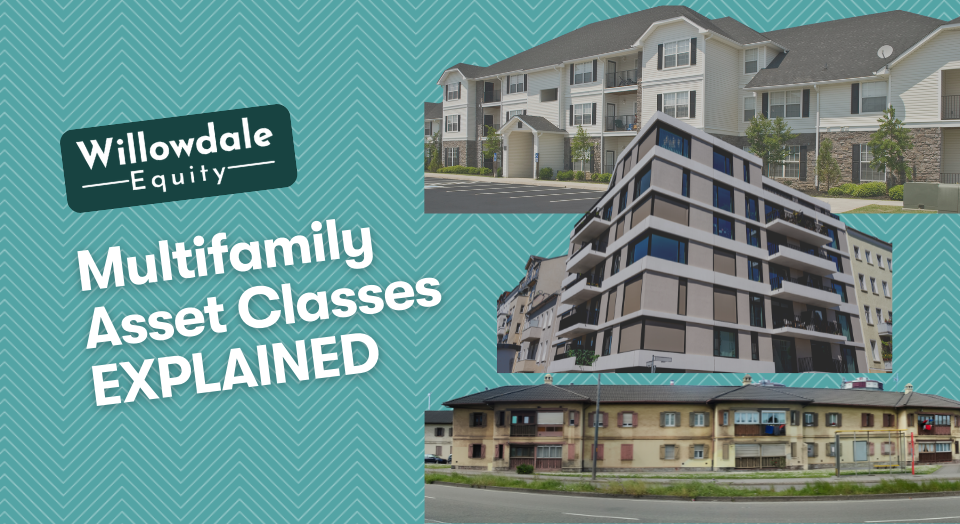
Class B Multifamily & The Two Other Asset Classifications
This article is part of our passive investors guide on real estate syndications, available here.
There are three main different property classifications in the multifamily asset class. Each classification tells us about things like when the property was built, how high or low the rents are in the location and a little about the tenant demographic who occupies it. Class B multifamily, for instance, is a prevalent class that real estate investors seem to throw around in conversation and have a high investment appetite for, but why?
In this article, we will discuss and highlight class b property and the three types of multifamily asset classes so that you can better understand each classification and which class might work best for your real estate investing needs.
Key Takeaways
-
Each classification tells us things like when the property was built, how high or low the rents are in the location, and a little about the tenant demographic who occupies it.
-
These classes help investors better classify multifamily properties effectively to communicate their property type.
-
Class B properties are generally older, have lower-paying tenants, and may or may not be professionally managed. They are one step down from Class A as their rental income is typically less, and there could be some deferred maintenance concerns.
-
Investing in class B multifamily seems to provide the highest risk-adjusted return for investors because the apartment building is a little bit older and neglected, which provides a more significant amount of opportunity to fix the said problems, optimize operations and add more value.
Investment property classes
Property classes for multifamily help us easily distinguish specific characteristics of a property in terms of risk, for instance, without ever knowing the address or seeing a given property. These classes help investors better classify multifamily properties effectively to communicate their property type.
There are three main types of multifamily assets that we’re going to speak about in this article, and they are as follows:
- Class A Multifamily
- Class B Multifamily
- Class C Multifamily
What is a Class A Multifamily property
These apartments are among the finest in their market and region, boasting top facilities, high-end amenities, high-income tenants, and low vacancies. They’re newer buildings constructed within the last 15 years.
Class A multifamily is professionally managed, located in the most robust market, and owned by large institutional investors. They also generally desire the top price with little or no deferred maintenance concerns.
Some attributes of a class A multifamily property are as follows:
- Low risk
- Highest collection rate
- Best location
- Lowest vacancy rates
- Highest average rents
- Generally, a newer built property no more than ten years old
- No deferred issues
Why invest in a Class A Multifamily property
You would invest in a class A multifamily property if you are very risk-averse and are looking for more of a turnkey investment. As noted above, class A is a newer build, so they don’t have issues because all the parts that make up the property are new. That means that fewer things can go wrong and do go wrong.
Also, you don’t have to hunt down tenants every month to collect as the tenant demographic is much higher earners compared to class B and C multifamily assets.
Characteristics of an A Class neighborhood

The following are some of the characteristics of a class A neighborhood in multifamily:
- Best location in the local market
- Lowest crime rates
- Strongest local school ratings
- Strong natural traffic
- Strong local economy
What is a Class B Multifamily property

Class B properties are generally older, have lower-paying tenants, and may or may not be professionally managed. They are one step down from Class A as their rental income is typically less, and there could be some deferred maintenance concerns. These buildings are mostly in good shape, which positions them as a strong “value-add” investment.
A value-add investment that, through strategic renovations, dollars can be improved and brought up from a Class B+ to a Class A. Buyers are frequently able to obtain class B assets at a slightly greater CAP Rate than a Class A multifamily property.
Some attributes of a class B multifamily property are as follows:
- Low to moderate risk
- Good collection rate
- Good location
- Average vacancy rates
- Strong average rents
- Generally, a little older built property, anywhere from 15-25 years old
- Some deferred issues
Why invest in a Class B Multifamily property
Investing in class B multifamily seems to provide the highest risk-adjusted return for investors because the apartment building is a little bit older and neglected, which provides a more significant amount of opportunity to fix the said problems, optimize operations and add more value.
This important value-add component is accompanied by lower risk as class B properties are still in solid areas with strong demand for rental housing.
Characteristics of a B Class neighborhood
The following are some of the characteristics of a class B neighborhood in multifamily:
- Good location in the local market
- Moderate crime rates
- Good local school rating
- Some natural traffic
- Good local economy
What is a Class C Multifamily property
Class C properties are typically much older than Class A and B properties, with an average age of more than 20-30 years old. They’re generally in less desirable areas, too. These properties typically need upgrading, such as upgrading the building’s infrastructure to keep it contemporary.
As a result, a Class C property has some of the lower rental rates in a market with other Class A or Class B properties. To produce consistent cash flow for investors, some Class C properties require significant renovation to provide more value to tenants and charge more effectively.
Some attributes of a class C multifamily property are as follows:
- Higher risk
- Moderate collection rate
- Moderate location
- Higher vacancy rates
- Moderate average rents
- Generally, an older property that’s 30-40 years old
- Many deferred issues
Why invest in a Class C Multifamily property
Investing in class C buildings is a substantial investment as there is some risk with the property’s age and its growing repairs that may need to be attended to, as well as a slightly weaker demographic of tenants in terms of median household income.
But with problems come the greatest opportunity, which means that if you can go in and make the right physical improvements to bring the property up to standard, as well as fix the tenant demographic, you can add a ton of value and swing the assets price on your exit.
Characteristics of a C Class neighborhood

The following are some of the characteristics of a class C neighborhood in multifamily:
- Moderate location in the local market
- Average crime rates
- Average local school rating
- Some natural traffic
- Moderate local economy
Difference between class A and class B apartments

Class A apartments are generally newer and have fewer deferred maintenance issues. They often have the best locations and highest rents in the local market. Class B apartments are usually older, have some deferred maintenance issues, and have average rents. Class A multifamily apartments are newer, have low risk, high collections rates, and are in the best locations.
In terms of class A vs. class B property as in investment, class A multifamily is more of a trophy asset that offers lower returns because they’re new builds or newer built properties with very few issues and generally a minimal opportunity to add value and take the property to the next level.
As opposed to class B, which possesses more substantial upside potential with very similar low-risk issues that can easily be fixed or improved upon takeover as a new buyer.
It’s always important to note that tenants living in class A usually try to cut back on their expenses during a recession. As a result, they tend to move down to Class B apartments, and class B tenants seem to do the same by moving down to class C apartments. This creates a ton of demand for rental housing in the B and C asset classes, which keeps vacancies low, and collections high for these types of assets.
Difference between class B and class C apartments

Class B and class C apartments differ because class B multifamily apartments are located in areas with more demand. In contrast, class C multifamily apartments are situated in low-rent areas with a higher crime rate. Class C multifamily properties are also not typically considered the number one choice area where people want to live or raise their families due to safety concerns. In addition, class C multifamily apartments often come at a discount in terms of pricing compared to class A or class B multifamily properties.
Class C multifamily properties are excellent for investors; these assets have a slightly higher risk profile but offer a more substantial return as an investment overall. That is because more problems and deferred repairs can be fixed, providing a tremendous upside. On the other hand, class B multifamily apartments offer lower returns. Still, they have lower vacancy rates and average solid rents since there is higher demand in the area where class B multifamily apartment deals are typically located.
The disadvantage of class C multifamily property investments is that you’ll likely make many repairs and renovations to bring them up to standard, which can be costly. But overall, class B multifamily offers the highest risk-adjusted return compared to class A and class C multifamily because it has all the vital attributes like strong rents, good location, and low crime rate. Still, being a little bit older of a property with a solid potential to add more value to the tenant base and charge more.
Good Read: What Are CRE Investments?
Frequently Asked Questions About Class B Property
It’s a step-down class from class D properties in multifamily and generally has the characteristics of an older property that needs attention. Also, the area it’s located in has high crime, delinquency issues, and a general demographic of low-earning tenants.
Class B neighborhoods tell the story of the level of quality in a given area. Class B neighborhoods generally are located within a good location in a market, have good local school ratings, a moderate crime rate, and a good local economy.
A class B building tells the story of what type of building quality a given structure is. Class B buildings are generally 15-25 years old and in good shape.
Class B Apartments - Conclusion
Ultimately, the multifamily asset class you choose to invest in depends on your risk tolerance and desired return. You should also consider other factors, such as how much time you have for property investment, what type of tenant demographic would work best with your needs, and whether or not you want to be hands-on with management tasks.
Each classification tells us things like when the property was built, how high or low the rents are in the location, and a little about the tenant demographic who occupies it. Class B and C multifamily real estate offer the greatest return on each dollar invested as they provide the stability of a low-risk investment instrument, a cash-flowing hard asset you can still touch and feel.
Also, with that upside, provide a better living standard for tenants and their families while generating a solid multiple on your invested dollars.
Here at Willowdale Equity, we focus on acquiring class B and C multifamily assets across the southeastern United States with the value-add strategy and focus in mind. If you’re interested in investing with us, you can click here to apply to join our investment club, where you’ll get access to exclusive multifamily investment opportunities as well as additional exclusive learning and resources.
Key Highlights
📈 Increase in Value After 15 Months – 80%
📈 Increase in Value After 21 Months – 119%
📈 Return of Investors Capital on Refinance – 62.5%




